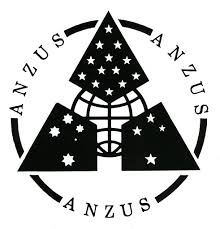 Spirit of Eureka Statement, September 9th, 2020
Spirit of Eureka Statement, September 9th, 2020
Since its ratification in 1951, Australian politicians and pundits have touted the ANZUS treaty as a guarantee of Australian security. The US in signing the treaty with Australia and New Zealand did not commit to automatically supporting those countries with military forces in the event of armed attack. Rather, there is a less stringent commitment to ‘consult’. Close reading of the actual text of the treaty reveals that it is not the security guarantee that it has consistently been made out to be.
In a July 2020 Discussion Paper for the Australia Institute, Allan Behm provides much in the way of insight into the ANZUS treaty. Starting with the historical background to the document, Behm describes the motives behind External Affairs Minister Percy Spender’s drive to extract a security guarantee from the US government. Spender was concerned about the Cold War but was also very concerned about Japanese re-armament. Spender wanted a NATO style agreement with the US, but his counterparts in the US government had their own ideas. US officials did not want to make too much in the way of a military commitment to come to the aid of Australia and New Zealand in the event of an armed attack on either country. US officials however wanted a commitment from Australia and New Zealand to a Peace treaty with Japan. As a form of quid pro quo the ANZUS treaty was signed in exchange for Australia signing a Peace treaty with Japan, a treaty that was opposed by many in Australia including some in the Menzies government. Japan was seen by the US as a certain ally in the Northeast Asia region, particularly since the ‘loss’ of China to the communists in 1949 and the advent of the Cold War.
So from its inception in 1951, the ANZUS treaty was a product of compromise and was less than what the Australian government wanted. Of course, this has not stopped the promotion of it as the cornerstone of Australian defence policy and guarantor of Australian security.
In his Discussion Paper Behm unpacks the actual contents of the treaty. [1] The ANZUS treaty is just over 800 words in length and is made up of what Behm calls preambular and operative paragraphs. The preambular paragraphs, of which there are five, are given a rather quick analysis by Behm but it seems that these paragraphs are along the lines of ‘motherhood’ statements with little in the way of the actual mechanics of the treaty. The nuts and bolts of the treaty are found in the eleven articles in the operative paragraphs. Of these eleven articles, articles 1,3,4 and 5 are the most important. Article 3 relates to possible threats to the signatories and is quite brief. “The Parties will consult together whenever in the opinion of any of them the territorial integrity, political independence or security of any of the Parties is threatened in the Pacific.” As Behm makes clear in his discussion of article 3, there is no explicit commitment to provide military forces; consultation would be sufficient to cover the signatories’ treaty obligations.
The wording of the articles is deliberately ambiguous, designed that way by US officials in order to avoid any automatic military commitment to its treaty partners. As Behm notes: ‘to assume any automaticity in the application of the operative paragraphs, especially in a time of heightened military tension involving any of the parties, would represent the triumph of hope over experience…’
International developments subsequent to 1951 have had their impact on Australian perceptions of the extent of US commitment to the ANZUS treaty. In 1969, frustrated by the increasing burdens on the US military and the escalating financial costs in prosecuting the war in Vietnam, President Nixon announced that he expected Asian countries to look to their own self-defence resources first before expecting US military aid. The Guam doctrine, as it became known, caused consternation in the Australian government and in defence policy circles. While Nixon did say that the US would honour existing treaties, nevertheless his Guam announcement signalled that the US would look to its own national interests first.
Australia has gone to war in support of the US on a number of occasions including in Korea, Vietnam, and Iraq, and put Australian naval, air or ground forces at risk of war with several other countries including Syria and Iran (still ongoing). None of these interventions had anything to do with the defence of Australia, but have been justified on the grounds that the US will only come to our support in the case of an external threat if we support them. This argument is deeply misleading, however, as it is only these interventions and the hosting of US bases on our soil that is likely to lead to such threats.
 The ANZUS treaty then has functioned as a security myth that is regularly used by politicians from the mainstream parties to placate the general public. New Zealand retired from the ANZUS treaty in the 1980s when it decided to go nuclear free and not allow US nuclear powered naval vessels to dock in its harbours. However, New Zealand continues to share intelligence with the US and Australia under the Five Eyes intelligence sharing agreement. This left just two signatories to the treaty. Australia has unofficially acknowledged the limitations of the ANZUS treaty and New Zealand’s retirement by entering into bilateral defence arrangements with the US. There are regular Ministerial level consultations between Australia and the US under the imprimatur of AUSMIN. The defence and security arrangements reached under the auspices of AUSMIN are the real basis of Australian defence and security policy rather than the ANZUS treaty.
The ANZUS treaty then has functioned as a security myth that is regularly used by politicians from the mainstream parties to placate the general public. New Zealand retired from the ANZUS treaty in the 1980s when it decided to go nuclear free and not allow US nuclear powered naval vessels to dock in its harbours. However, New Zealand continues to share intelligence with the US and Australia under the Five Eyes intelligence sharing agreement. This left just two signatories to the treaty. Australia has unofficially acknowledged the limitations of the ANZUS treaty and New Zealand’s retirement by entering into bilateral defence arrangements with the US. There are regular Ministerial level consultations between Australia and the US under the imprimatur of AUSMIN. The defence and security arrangements reached under the auspices of AUSMIN are the real basis of Australian defence and security policy rather than the ANZUS treaty.
The Five Eyes intelligence sharing (spying) treaty between the US, UK, Australia, Canada and NZ is a key part of the US-Australia alliance. So is the daily operation of US bases on Australian soil; Pine Gap, NW Cape, Robertson Marine Barracks and Tindal RAAF base, the latter being upgraded at Australian cost ($1 billion-plus) to accommodate and refuel US nuclear bombers within range of Southern China.
Together these facilities and the alliance tie us so closely to US foreign policy that we are not only a nuclear target but a subject of Chinese economic retaliation – from coal to barley to wine exports. There is no doubt that Australian governments are sacrificing economic welfare (alienating our biggest trading partner) for the US alliance – which graphically illustrates how subservient our governments are, and how little concern they have for the welfare of the Australian people. This is on top of the human and financial costs of involvement in US wars from Korea through Vietnam, Iraq and Afghanistan. The biggest impact would come from a war with China, which we are currently risking through deference to the US. How is that in Australia’s interests?
[1] https://www.tai.org.au/content/anzus-and-australia-s-security Link on webpage to PDF.



